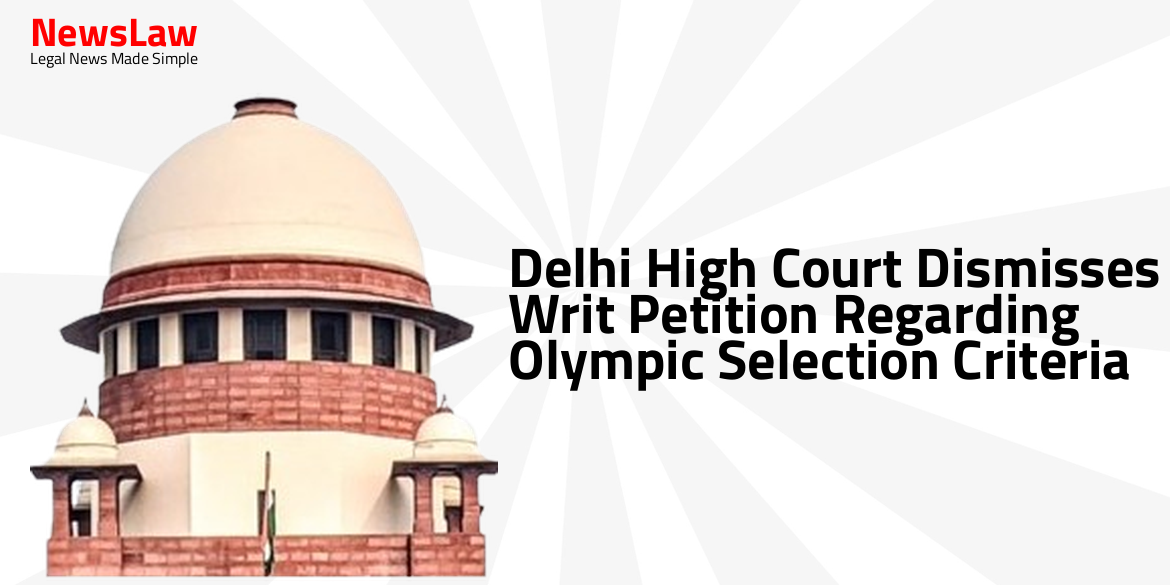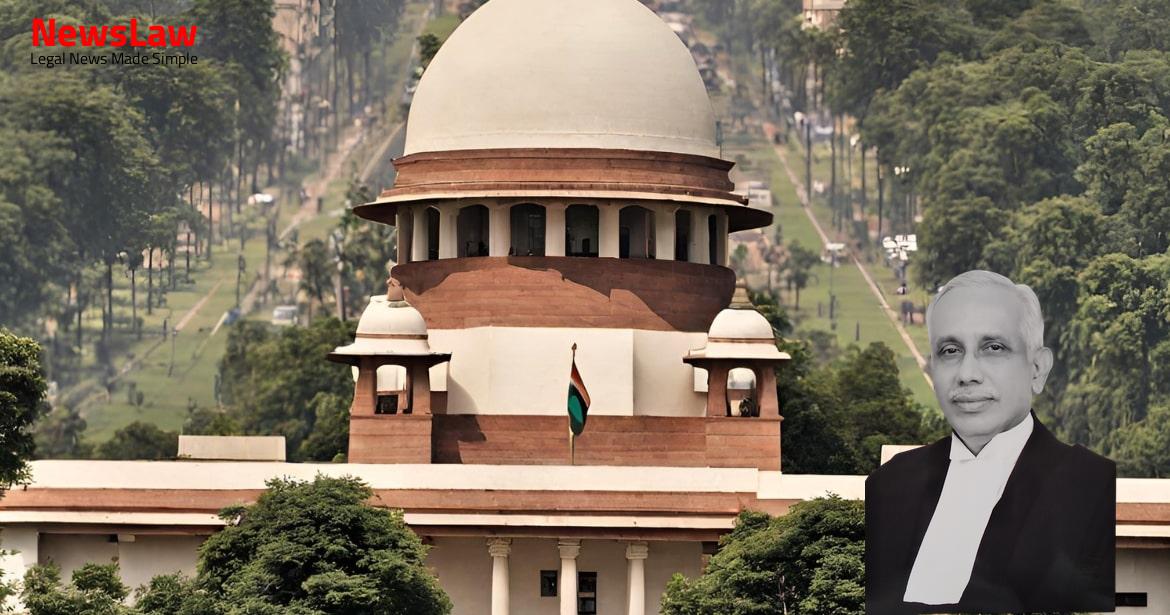In a significant legal case involving stamp duty dispute resolution, the Supreme Court of India has set a precedent regarding the role of the District Registrar. The case revolves around the determination of deficit stamp duty and penalty, impacting the admissibility of a crucial document in evidence. This ruling sheds light on the procedural intricacies of stamp duty regulations and the authority vested in the District Registrar, ensuring fair and transparent resolution of disputes.
Facts
- The appellant filed Writ Petition No 8506 of 2018 challenging the trial court’s order before the High Court of Karnataka.
- The High Court dismissed the Review Petition and the Writ Petition on 10.08.2018.
- The appellant sought possession through the agreement of sale, which was considered a conveyance.
- The appellant filed Writ Petition No 30734 of 2019 challenging the order in O.S. No. 5295 of 2013, seeking relief from deficit stamp duty and penalty.
- The Writ Petition was dismissed, granting a four-month period for payment of dues.
- The appellant filed Review Petition No 340 of 2019 against the order dated 14.09.2021.
- An application was filed under Section 33 of the Act to impound the suit agreement for deficit stamp duty and penalty collection.
- The District Registrar determined total stamp duty and penalty as Rs. 7,83,200.
- The appellant tried to protect possession claimed under the agreement of sale through a prayer for perpetual injunction.
- The District Registrar returned the instrument due to missing details, which the appellant attempted to rectify.
- The trial court rejected the appellant’s memo purporting to clarify missing details in the agreement.
- The scope of relevant sections of the Karnataka Stamp Act, 1957, came into consideration in these Civil Appeals.
- Exchange of notices occurred between the appellant and the respondent regarding the agreement of sale dated 29.06.1999.
- The trial court sent the agreement of sale to the District Registrar for determination of stamp duty and penalty.
- The District Registrar determined deficit stamp duty at Rs. 71,200.
- The appellant’s narrative relies on the existence of the agreement of sale dated 29.06.1999 for part performance and possession of the property.
- The agreement clauses not relevant to the case were not discussed in detail.
- Through the Impugned Order, the Learned Single judge concluded that the Review Petition fails.
- The appellant was granted a period of six months’ time to pay the deficit stamp duty along with ten times penalty.
- The trial court directed the appellant to pay the deficit stamp duty of Rs.71,200/- and ten times penalty on the agreement of sale dated 29.06.1999.
- The adjudicating authorities do not have the discretion to disobey the legislative command to waive or reduce the penalty.
- The Section employs the expression “ten times the amount of the proper duty or deficit portion thereof,” lacking discretion to waive or reduce the penalty.
- Only on the payment of deficit stamp duty along with ten times penalty, the suit agreement is relied in evidence.
Also Read: Landmark Judgment on Division of Ancestral Property: Legal Battle Between Family Heirs
Issue
- The issue at hand is whether the trial court’s order dated 23.01.2019, affirmed by subsequent orders, is legal and valid or requires intervention by the Court under Article 136 of the Constitution of India.
- The legality and validity of the trial court’s order dated 23.01.2019, upheld by the orders dated 23.08.2019 and 14.09.2021, is being questioned in the present case.
- The key question is whether the Court should interfere in the aforementioned orders based on the facts and circumstances presented.
Also Read: Revocation of Power of Attorney: The Case of George vs. Thomas
Arguments
- Appellant argues that the case falls under Section 37(2) of the Act.
- Impugned orders denied the appellant the option to have the penalty decided by the District Registrar.
- Trial court and High Court committed an illegality by exercising jurisdiction under Section 34 of the Act.
- Counsel argues that the suit document conforms to Act requirements and was for injunction.
- Even if the suit document is not stamped correctly, trial court should have sent it to District Registrar for determining stamp duty and penalty.
- The ratio in Chilakuri Gangulappa case is not applicable to the facts and circumstances of this case.
- This argument suggests that the principles established in the Chilakuri Gangulappa case do not directly relate to the current case.
- It implies that the reasoning or decision in the Chilakuri Gangulappa case cannot be used as a precedent or guideline for determining the outcome of this case.
Also Read: Family Property Settlement Agreement: Upholding Rights of Plaintiff No. 2
Analysis
- Having taken legal custody of the insufficiently stamped document, the inter-play available between Sections 33, 34, 37, 38 and 39 of the Act would start operating.
- This provision bars the admission of an instrument in evidence unless adequate stamp duty and the penalty are paid.
- Every person so authorised to collect deficit stamp duty and penalty has no discretion except to levy and collect ten times the penalty of deficit stamp duty.
- Sub-section (2) of Section 33 of the Act fastens an obligation to examine the instrument on the duty payable, value etc. of the instrument.
- The plain reading of Section 37(1) of the Act discloses that the person impounding the instrument under Section 33 of the Act and after receiving the penalty under Section 34 of the Act or duty under Section 36 of the Act shall send to the Deputy Commissioner an authenticated copy of such instrument together with the amount of duty and penalty so levied and collected.
- Thereupon, the District Registrar would have exercised his discretionary jurisdiction under Section 39 of the Act and determined the quantum of penalty payable by the appellant.
- This Court upheld the ratio laid in Digambar Warty (supra) and held that even though no discretion was provided to the court to impose a reduced penalty, Section 38 of the Act empowered the Deputy Collector to refund the duty so collected.
- Agreement of sale dated 29.06.1999, among other clauses, refers to the alleged delivery of possession in favour of the appellant by the respondent.
- Article 5 of the Schedule of the Act deals with an agreement of sale coupled with possession and the requirement of paying the ad valorem stamp duty.
- The settled distinction and discretion available under Sections 34 and 39 of the Act is no more res integra.
- This Section provides the procedure to be followed by the Deputy Commissioner/District Registrar while stamping instruments that are impounded under Section 33 of the Act.
- As per Section 39(1)(b) of the Act, the penalty may extend to ten times the stamp duty payable; however, ten times is the farthest limit which is meant only for very extreme situations.
- In either of the cases, after the deficit stamp duty and the penalty are paid, the impounding effected under Section 35 of the Act is released and the instrument available to the party for relying as evidence.
- In the event, a party prefers to have the document sent to the deputy commissioner for collecting the deficit stamp duty and penalty, the Court/Every Person has no option except to send the document to the District Registrar.
- We are confirming the findings of the High Court in this behalf.
- On the contrary, the trial court has called for a report from the District Registrar, so for all purposes, the suit instrument is still at one or the other steps summed up in paragraph 21.
- However, there are a few misgivings in the sequence of its application. Section 37 of the Act is titled instruments impounded, how dealt with.
- This Section arises when the party pays the deficit duty and penalty, the Court is to impound the instrument under Section 33 of the Act and has to forward the instrument to the Deputy Commissioner/District Registrar.
- Therefore, the Deputy Commissioner/District Registrar has discretion to levy and collect commensurate penalty.
- Section 37(2) of the Act deals with an instrument not subjected to the procedure of Sections 34 or 36 of the Act.
- According to Section 37(2) of the Act, the instrument is sent to the Deputy Commissioner for inquiry and decision at his end.
- The court observed that as per the combined reading of the sections, if the impounding authority determined the penalty under Section 37(1) of the Act, and thereafter, sends the document to Deputy Commissioner under Section 37(2) of the Act, then the Deputy Commissioner will have the power to reduce the penalty under Section 38 of the Act.
- The above consideration does not actually address the appellant’s argument under Section 37(2) read with Section 39 of the Act.
- The Stamp Act itself provides for the manner in which the defect may be cured and sets out a detailed procedure for it.
- It bears mentioning that there is no procedure by which a void agreement can be “cured.
- The trial court is yet to exercise its jurisdiction under Section 34 of the Act.
- The caveat to the above is that, before the Court/Every Person exercises the jurisdiction under Section 34 of the Act, the option must be exercised by a party.
- It is unnecessary for us to say that the Collector is not required by law to impose the maximum rate of penalty as a matter of course whenever an impounded document is sent to him.
- The scheme does not prohibit a party to a document to first invoke directly the jurisdiction of the District Registrar and present the instrument before Court/Every Person after complying with the requirement of duty and penalty.
- In such an event, the available objection under Sections 33 or 34 of the Act is erased beforehand.
- The quantum of penalty is primarily between the authority/court and the opposing party has little role to discharge.
- Therefore, going by the request of the respondent, the option is left for the decision of the District Registrar.
- Section 34 of the Act is titled instruments not duly stamped inadmissible in evidence.
- The District Registrar has sent a report on the stamp duty payable but has not collected the deficit stamp duty or levied the penalty on the suit agreement.
- Unless it is duly stamped, Section 34 of the Act prohibits Every Person/Court from admitting in evidence or act upon an insufficiently/improperly stamped instrument.
- In the case on hand, the dispute arose on the application filed by the respondent requesting to send the suit document to the District Registrar for the determination of duty and penalty.
- Therefore, by relying on the above judgments, it is held that the appellant, with a view to produce in evidence the agreement of sale in the suit, must pay the deficit stamp duty and penalty. Chapter VI]2.
- It is apposite to refer to the declaration of law by a seven-judge bench’s judgment of this Court on the object of the Indian Stamp Act, 1899.
- Therefore, the option available under Section 33 read with Section 37 of the Act is set in motion, resulting in the instrument being sent to the District Registrar and calling for a report.
- Sections 33 and 34 clearly indicate that the penalty imposed has to be 10 times approximated, as the legislature has not vested the discretion given to the Deputy Commissioner under Section 39 of the Act in the same way to the adjudicating authorities under Section 34 of the Act.
- The ratio in all fours is applicable to the circumstances of the case.
- In Trustees of HC Dhandha Trust v. State of Madhya Pradesh, the Court held that the penalty under Section 40(1)(b) of the Indian Stamp Act cannot be imposed automatically in case of stamp duty deficiency.
- Improper stamping does not render an instrument void or invalid.
- The imposition of penalty should be reasonable and not oppressive, considering factors like fraud or deceit.
- Non-payment of stamp duty is seen as a curable defect.
- Section 35 of the Indian Stamp Act requires proper stamping for an instrument to be admissible in evidence.
- The Act is a fiscal legislation and should not be used as a technicality in litigation.
- The authority impounding a document does not have discretion in collecting duty under Section 33.
- Section 33 of the Karnataka Stamp Act, 1957 deals with the examination and impounding of instruments.
- The purpose of this provision is to prevent individuals from withdrawing instruments when informed that proper stamp duty and penalty must be paid.
- Section 37 states that no instrument chargeable with duty shall be admitted in evidence unless duly stamped.
- The impounding officer must send an authenticated copy of the instrument to the Deputy Commissioner along with the levied duty and penalty.
- Section 39 outlines the Deputy Commissioner’s power to stamp impounded instruments.
- The Deputy Commissioner can certify an instrument as duly stamped, require payment of proper duty and penalty for under-stamped instruments, or remit penalties in certain circumstances.
- Certificates issued by the Deputy Commissioner are conclusive evidence of the stated matters.
- If an instrument is sent to the Deputy Commissioner, it must be returned to the impounding officer after being dealt with.
- Section 34 of the Act declares that instruments not duly stamped are inadmissible in evidence unless certain conditions are met.
- Individuals relying on insufficiently stamped instruments have the option to pay duty and penalty under Section 34 or move an application under Section 39 to the District Registrar.
- The law provides options for addressing insufficient or improper stamping of instruments to ensure compliance with stamp duty regulations.
- The imposition of penalty of ten times in this case is deemed illegal and contradicts the procedures outlined in paragraph 21.
- The instrument is first sent to the District Registrar, who then determines the stamp duty and penalty as per the jurisdiction under Section 39 of the Act.
- Despite the instrument being insufficiently stamped, the penalty of ten times under Section 34 of the Act was imposed in the impugned orders, which goes against the admitted circumstances.
- The appellant is being deprived of the option to pay the determined amount by the District Registrar, as the Court has imposed the penalty under Section 34 of the Act.
- The appellant is obliged to pay what is rightfully due as decided by the District Registrar, not by the Court under Section 34 of the Act.
Decision
- The direction to pay ten times the penalty of the deficit stamp duty has been set aside.
- All objections available to the parties except the penalty issue are left open for consideration.
- The trial court is instructed to send the agreement of sale dated 29.06.1999 to the District Registrar for determining the deficit stamp duty and penalty.
- Upon receiving the compliance certificate from the District Registrar, the suit document will be received in evidence without reference to any other objections under the Act.
Case Title: SEETHARAMA SHETTY Vs. MONAPPA SHETTY (2024 INSC 650)
Case Number: C.A. No.-010039-010040 – 2024



